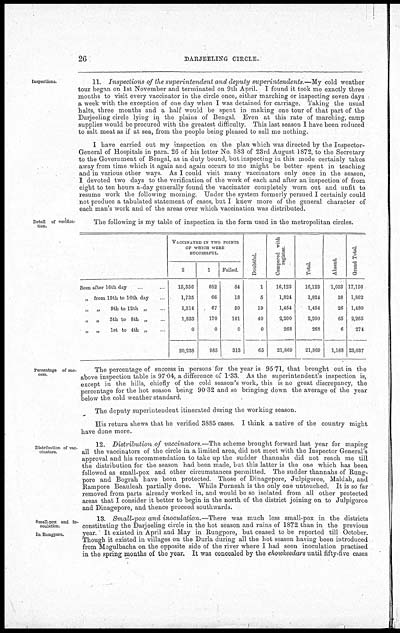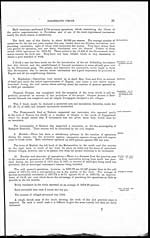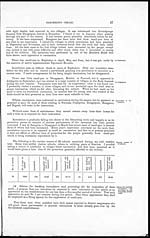Medicine - Vaccination > 1869-1873 - Report on vaccination in the Province of Bengal > Report on vaccination in the Province of Bengal for the year ending 31st March 1873
(415) Page 26
Download files
Individual page:
Thumbnail gallery: Grid view | List view

26 DARJEELING CIRCLE.
Inspections.
11. Inspections of the superintendent and deputy superintendents.—My cold weather
tour began on 1st November and terminated on 9th April. I found it took me exactly three
months to visit every vaccinator in the circle once, either marching or inspecting seven days
a week with the exception of one day when I was detained for carriage. Taking the usual
halts, three months and a half would be spent in making one tour of that part of the
Darjeeling circle lying in the plains of Bengal. Even at this rate of marching, camp
supplies would be procured with the greatest difficulty. This last season I have been reduced
to salt meat as if at sea, from the people being pleased to sell me nothing.
I have carried out my inspection on the plan which was directed by the Inspector-
General of Hospitals in para. 26 of his letter No. 583 of 23rd August 1872, to the Secretary
to the Government of Bengal, as in duty bound, but inspecting in this mode certainly takes
away from time which it again and again occurs to me might be better spent in teaching
and in various other ways. As I could visit many vaccinators only once in the season,
I devoted two days to the verification of the work of each and after an inspection of from
eight to ten hours a-day generally found the vaccinator completely worn out and unfit to
resume work the following morning. Under the system formerly persued I certainly could
not produce a tabulated statement of cases, but I knew more of the general character of
each man's work and of the areas over which vaccination was distributed.
Detail of verifica-
tion.
The following is my table of inspection in the form used in the metropolitan circles.
|
VACCINATED IN TWO POINTS |
Doubtful. |
Compared with |
Total. |
Absent. |
Grand Total. |
|||
|
2 |
1 |
Failed. |
||||||
|
Seen after 16th day ... ... |
15,356 |
682 |
84 |
1 |
16,123 |
16,123 |
1,033 |
17,156 |
|
„ from 13th to 16th day ... |
1,735 |
66 |
18 |
5 |
1,824 |
1,824 |
38 |
1,862 |
|
„ „ 9th to 12th „ ... |
1,314 |
67 |
50 |
19 |
1,454 |
1,454 |
26 |
1,480 |
|
„ „ 5th to 8th „ ... |
1,833 |
170 |
161 |
40 |
2,200 |
2,200 |
65 |
2,265 |
|
„ „ 1st to 4th „ ... |
0 |
0 |
0 |
0 |
268 |
268 |
6 |
274 |
|
20,238 |
985 |
313 |
65 |
21,869 |
21,869 |
1,168 |
23,037 |
|
Percentage of suc-
cess.
The percentage of success in persons for the year is 95.71, that brought out in the
above inspection table is 97.04, a difference of 1.33. As the superintendent's inspection is,
except in the hills, chiefly of the cold season's work, this is no great discrepancy, the
percentage for the hot season being 90 32 and so bringing down the average of the year
below the cold weather standard.
The deputy superintendent itinerated during the working season.
His return shews that he verified 3885 cases. I think a native of the country might
have done more.
Distribution of vac-
cinators.
12. Distribution of vaccinators.—The scheme brought forward last year for maping
all the vaccinators of the circle in a limited area, did not meet with the Inspector General's
approval and his recommendation to take up the sudder thannahs did not reach me till
the distribution for the season had been made, but this latter is the one which has been
followed as small-pox and other circumstances permitted. The sudder thannahs of Rung-
pore and Bograh have been protected. Those of Dinagepore, Julpigoree, Maldah, and
Rampore Beauleah partially done. While Purneah is the only one untouched. It is so far
removed from parts already worked in, and would be so isolated from all other protected
areas that I consider it better to begin in the north of the district joining on to Julpigoree
and Dinagepore, and thence proceed southwards.
Small-pox and in-
oculation.
In Rungpore.
13. Small-pox and inoculation.—There was much less small-pox in the districts
constituting the Darjeeling circle in the hot season and rains of 1872 than in the previous
year. It existed in April and May in Rungpore, but ceased to be reported till October.
Though it existed in villages on the Durla during all the hot season having been introduced
from Mogulbacha on the opposite side of the river where I had seen inoculation practised
in the spring months of the year. It was concealed by the chowheedars until fifty-five cases
Set display mode to: Large image | Zoom image | Transcription
Images and transcriptions on this page, including medium image downloads, may be used under the Creative Commons Attribution 4.0 International Licence unless otherwise stated. ![]()
| India Papers > Medicine - Vaccination > Report on vaccination in the Province of Bengal > Report on vaccination in the Province of Bengal for the year ending 31st March 1873 > (415) Page 26 |
|---|
| Permanent URL | https://digital.nls.uk/91535865 |
|---|
| Additional NLS resources: | |
|---|---|




